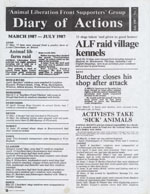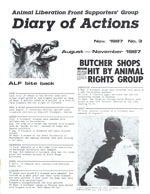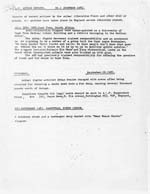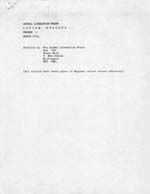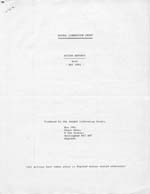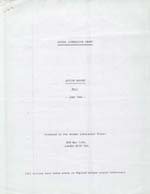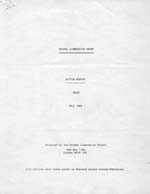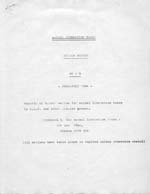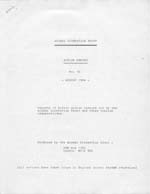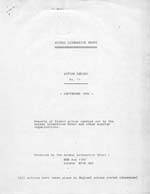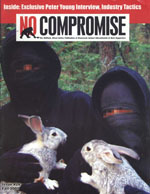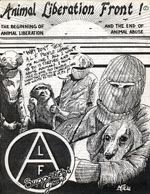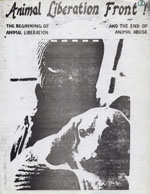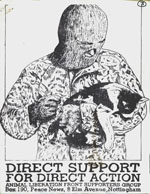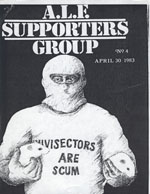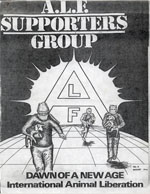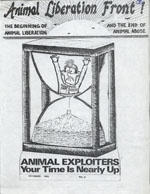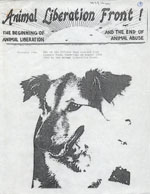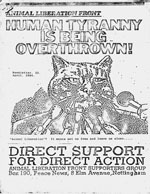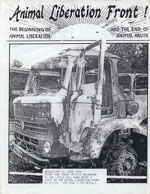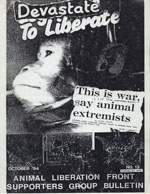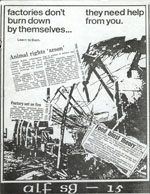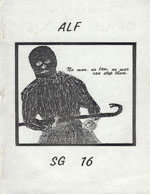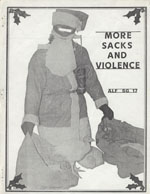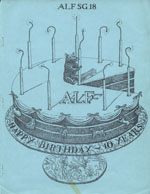» Next Entries
The Archives
-
Periodicals
ALFSG Diary of Actions #1-3
06.03.13 | PermalinkALFSG – Diary Of Actions #1-3 (1986-1987. London, England)
After the end of volume one of “The SG,” England’s ALF Supporters Group produced the short lived “Diary of Actions.” Each issue was distributed for free and contained brief accounts of anonymous direct actions across the globe. In the pre-internet world this was the best available source for such information, and these magazines are still an excellent catalog of resistance against animal abuse in the mid-1980s.
…
-
Most Popular, No Compromise, Periodicals
No Compromise: The Final Two Issues
05.13.13 | PermalinkNo Compromise #29-30 (2006. Santa Cruz / San Francisco, CA)
The early days of my activism were so exciting. After a lifetime of feeling powerless I suddenly discovered that there was a community dedicated to fighting the good fight. Its members were in every major city and many smaller ones, and sometimes not living in any city at all, but in trees and encampments. The people involved were empowered to act for themselves in order to create a better world, and had abandoned all the false hope of political parties and their dead politics. Words meant little, action was what counted, and the sky was the limit. The internet was not yet in wide use, and thank goodness! That meant that we met each other in conference rooms, in squats, on the streets, and sometimes on the pages of No Compromise magazine.
No Compromise shaped who I am today. Each new issue contained articles that helped me and thousands of others to evolve our own style of resistance, and as our experience grew we were able to share our stories in the pages of the magazine.
After 30 issues, the steering committee of No Compromise decided to stop publishing in 2006. Their decision could not have come at a worse time. With the SHAC website and newsletter killed by the convictions of the SHAC 7, Bite Back being published only sporadically and with a limited focus, and the Earth First! Journal mired in its “Confronting Oppression Within” drama, the sudden absence of No Compromise meant that the primary sources for radical animal liberation news, opinion, and strategy were the twin sewers of online social networks and the North American Animal Liberation Press Office. These were dark times for our movement, and we are only just beginning to recover.
The final issues of No Compromise were the best of the series, though! I was in prison when issue 30 was released, and it felt electric in my hands. I read it over and over, alternately laughing and crying. As I was putting this post together I decided to pull out that print copy. It gave me the same sense of awe I had when I read those first issues. More than that, it reminded me that there is still a community of people capable of changing the world through compassionate direct action and mutual aid. And you know what? We are going to win!
KEEP FIGHTING,
Josh Harper(The complete set of all past issues of No Compromise can be found HERE)
…
-
Periodicals
ALF Action Reports
04.15.13 | PermalinkA.L.F. Action Reports #1-11 (1983-1984. London, England)
Because the Animal Liberation Front is without central leadership and exists more as tactic than an organization, most volunteers were never recruited. Instead, they were people who heard about other actions, and when their conscience could take no more of the brutality surrounding them, decided to take actions of their own. By 1983 the government of England was well aware of this. Police PR departments were told to deny that attacks were happening, newspapers were pressured to stop covering direct actions for animals, and raids were carried out against the ALF Supporters Group and other producers of movement media. The government’s logic was that if people were unaware of the Front’s existence, perhaps membership would be lower and fewer attacks would be carried out.
This made it very difficult for interested parties to keep abreast of the multiple actions happening in England every single night. In response the ALF’s press office began to distribute Action Reports, a typewritten diary of every known direct action for non-humans for the month it was produced. In some cases full statements from participants in the underground would be published, other times reports were compiled from mainstream news articles.
The idea of Action Reports soon spread to Australia, the United States, and elsewhere. Eventually these reports evolved into the “Diary of Actions” that became common in radical AR publications such as No Compromise.
…
-
No Compromise, Periodicals
No Compromise #27-28
03.18.13 | PermalinkNo Compromise #27-28 (2005. Santa Cruz / San Francisco, CA)
The volunteer staff of No Compromise may have only published two issues in 2005, but both were valuable sources of news and ideas from across the globe. As always, the reports inside are bitter sweet. Many animals were rescued, many abusers felt some heat, and many people rose up and fought back. Then, there was the backlash, the senate hearings, and the arrests. The movement has never stopped though, and No Comp always served as a reminder that come hell or high water we were all going to forge ahead, sometimes stronger, sometimes weaker.
One unfortunate development in 2005 was the arrest and conviction of Chris “Dirt” McIntosh. Despite receiving movement support, Chris turned to Nazi groups in prison for advice and friendship. Soon, he counted himself among their ranks, and requested to be removed from animal lib prisoner lists. He would have been removed anyway though: there is never room in our struggle for a Nazi!
Luckily, other prisoners continued to show courage, dignity, and resolve from behind bars. Both 2005 issues of NC contain inspiring letters and interviews with jailed comrades. All in all, this is another must read year for the best animal liberation publication to come out of the United States.
…
-
Most Popular, Periodicals, The SG (original 80s volume)
The ALF Supporters Group Newsletter – The complete original set!
03.04.13 | PermalinkThe ALF Supporters Group Newsletter #1-19 (1982-1986. Nottingham / London, England)
When this archive project was founded two years ago, a list was made of the ten publications that we “had to have.” Number one was a complete set of the first volume of “The SG.” This was a tall order, and we knew it. First off, the Animal Liberation Front Supporters Group must be one of the most raided entities in England, and its members were frequently raided themselves! The result was that many copies of the magazine ended up in police custody both before and after distribution, never to be seen again. Second, it was a relatively old newsletter, and since the first issues were mimeographed on cheap paper, finding intact copies was going to be difficult. We persevered though, and now these rare pieces of movement history are preserved digitally and online for everyone to read and learn from.
Started by Dave Nicholls in 1982, the ALF Supporters Group was an effort to do two things: 1.) To raise funds for people arrested for animal related direct actions. 2.) To create a broader base of support for the Animal Liberation Front inside the movement. Both goals were met quickly. Within two weeks of their founding, the Supporters Group hit the number of members they had set as their long term goal. Through direct donations, memberships, fundraising events, and sales of merchandise, the SG was able to contribute towards the sizable legal costs of activists being arrested across England.
The newsletter itself went through varying degrees of quality in writing, layout, and value to the movement. The early days of the Nicholls run may have had a drab interior, but the hand illustrated covers were sometimes gorgeous, and the rhetoric had not yet strayed into the more-militant-than-thou nonsense which came later. Eventually the writing would border on the cultish, but there is scarcely an issue of the magazine that doesn’t have some redeeming value. When read critically and as a whole body of work, this magazine follows the rise and spread of underground action for animals across the globe, illustrates the value of coalition building, and provides solid examples of extremism to be avoided through coverage of groups like the Animal Rights Militia. It also provides many historical details found nowhere else!
“The SG” has gone through several incarnations since British Law enforcement shut this one down in 1986. (While carrying out the investigation for the notorious Sheffield trial that sent Ronnie Lee to prison for 10 years, the police raided the SG and charged it’s editors with incitement. Everything published by the SG afterwords had to be run past a lawyer first, but this didn’t stop further raids, arrests, and convictions of those involved in the newsletter.) It is still being published today, copies can be ordered from www.alfsg.org.uk.
Finally, an excellent analysis and critique of the SG and the rise of England’s “Cult of Militancy” can be found in the book Against All Odds, available here at the Talon Conspiracy.
…
-
No Compromise, Periodicals
No Compromise #23-26
02.17.13 | PermalinkNo Compromise 23-26 (2004, Santa Cruz / San Francisco, CA)
One of the lessons that archiving old animal liberation publications has taught me is that the most extreme actions have rarely produced much in the way of results for animals. A public that already sees veganism as odd might still see the value of rescuing animals from a laboratory, but will never support a car bombing. When innocents are injured, or when murder was the goal, the backlash starts to creep into our own ranks, and as we fracture law enforcement and industry groups take advantage. In the end, I can think of no bombing (or contamination, or grave robbing, etc.) which advanced the cause of animal rights more than it harmed it. This is not to say that bombings and the like could never be successful. At later stages of many revolutionary struggles, when the majority of the public supports the cause, bombs can clear away in one night what years of protest could not. While a movement is in its infancy, however, it could be argued that more often than not bombs blow up in our faces.
And so it was in 2004 when a group calling itself the Revolutionary Cells Animal Liberation Brigade carried out two bombings of HLS related targets in California. The movement was left to make lemonade from truly shitty lemons, and No Compromise did their best to mitigate the harm of the actions while keeping activists focused on the real enemy.
The year continued with the indictment of the SHAC 7, the emergence of Austria as a leader in the movement, and some exciting open rescues. Sarahjane Blum and Ryan Shapiro’s organization, GourmetCruelty.com, carried out one such operation that piqued public interest and eventually resulted in a sympathetic program on Animal Planet. Elsewhere Gina Lynn was imprisoned for defying the Seattle grand jury, Billy Cottrell was arrested for a massive SUV dealership arson, and the Universtiy of Iowa was treated to the most sophisticated lab raid to occur since the early 90s.
Every time we post a year of No Compromise we say the same thing: that this is essential reading for those who wish to understand the recent history of our movement. This posting is no exception. No Compromise was the best AR publication of its era, and 2004 saw the publication refining its strengths and providing their readers with four of the best issues yet.
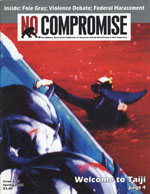



-
No Compromise, Periodicals
No Compromise #20-22
11.15.12 | PermalinkNo Compromise #20-22 (2003. Santa Cruz / San Francisco, CA)
No Comp scored another great year in 2003, this time by going deeper into practical instructions for campaigning, and also by examining the smaller stories in greater detail. While the high profile victories of anti-HLS activists were given their due, inspirational figures who had passed on were also given touching coverage. Issue #20 features articles on early Band of Mercy and Animal Liberation Front founder Sue Smith, and Sweden’s animal lib die-hard, Ake Soderlund. Similar examinations of our past, and the courageous figures whose shoulders we stand upon, pepper the 2003 issues. Of particular note is the article on Henry Hutto in issue #21.
2003 was also the year that Rod Coronado finally got off of probation and was allowed to participate in the movement again. His writings for No Compromise were as subversive and inspiring as ever, and it is easy to see why the government considered him such a threat.
As the year progressed No Comp moved to a magazine format and tightened their graphic design skills in response to Jake Conroy’s work on the SHAC USA newsletter. These glossy issues were excellent contributions to the movement, and it is a shame that in only a few more years NC would cease to exist altogether. These information (and inspiration!) packed issues are worth reading again to inform and encourage our current actions.


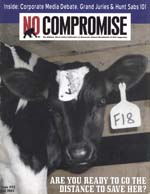
-
No Compromise, Periodicals
No Compromise #18-19
10.23.12 | PermalinkNo Compromise #18-19 (2001-2002. Santa Cruz, CA.)
If you have been following our posting of the complete No Compromise than you have read along as the new, 1990s militant grassroots took its first steps, stumbling along an exciting, and at times error filled path towards animal liberation. Those early years saw a lot of dedication and courage, but sadly little in the way of new tactics or intelligent planning.
That all changed in 2001 with the arrival of the anti-HLS campaign in the United States. The focus suddenly shifted from scattershot regional targeting to a single, international pressure point and the results were encouraging.
2001 wasn’t just about the fight against Huntingdon. The tactics developing in that one small struggle were inspiring activists globally to step up the fight against all areas of animal abuse, and sadly, some of our friends ended up in prison as a result. The support of these jailed comrades was inspiring, but our movement was dealt a terrible blow as Barry Horne died on Hungerstrike. That was not the only tragedy we would witness in these 12 months. Jeff Luers was sentenced to nearly 23 years in prison for an act of sabotage which harmed no one. Animal liberationists had been a strong force in the growing movement against globalization of capitalism, and at the 2001 G8 summit we watched as protestors and media were brutalized and bloodied in the lead up to the police murder of Carlo Giuliani. And of course, non-humans continued to be slaughtered in endless, unfathomable numbers. The tone of these two issues of No Compromise may have been optimistic, even cocky, but those of us on the ground knew that times were tough and getting tougher.
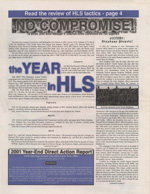

-
Periodicals
Animal Info
10.18.12 | PermalinkAnimal Info #1-8 (1995-1996. Christchurch, New Zealand)
Animal Info was a thin, photocopied newsletter that was published with the hopes of increasing the militancy of New Zealand’s animal activists. It’s pages contained news relevant to local campaigns, alongside the home addresses and phone numbers of various animal abusers. The zine’s rhetoric was, at times, over the top and even once racially insensitive. Issue #1 contains an N-bomb on the front page that was seemingly intended to make an anti-racist / speciesist point, but instead has the exact opposite effect.
Still, Animal Info is an inspiring example of committed activists organizing on a grassroots level and agitating for greater commitment in the struggle against speciesism. It’s international news coverage was impressive given the magazines small number of pages, and nicely bridges the U.S. coverage lapse between the time Open the Cages stopped publication and No Compromise began. All of us at CG would love to see this type of paper return to regional organizing in the United States and abroad.
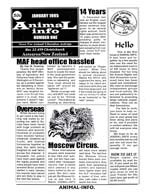
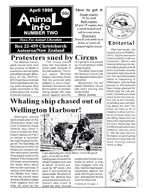
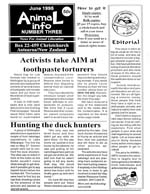


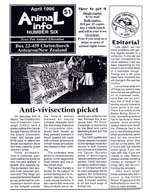
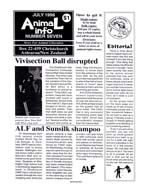
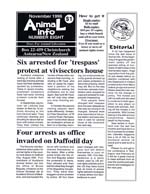
-
Periodicals
Facklan
10.11.12 | PermalinkFacklan (1996-1997 Umea, Sweden)
(Editors note: Facklan is a Swedish language publication that we bring to you due to its historical significance. Umea, Sweden produced one of the most remarkable animal liberation communities of the 1990s. Their influence was so strong that politicians in Sweden stated in national media that they feared animal rightists may collapse the countries infrastructure, both through sabotage and the conversion of the nations youth to veganism. Facklan was produced during the infancy of this tiny, but formidable uprising. One of our readers from Sweden has offered the summary that follows.)
Facklan (The Torch) was a Swedish magazine supporting the A.L.F. and
other radical groups fighting for the animals. It was released in four
issues in 1996-1997, during the biggest peak of A.L.F. activity in the
1990:ies in Sweden. The magazine was based in the northern city Umea,
which was well known for it’s number of vegans and animal rights
activists, militant (all fur shops closed in Umea as a result of the
A.L.F.) as well as non militant (almost 50 percent of the students at
some schools were vegetarians). Umea was often referred to as the
“Vegan Mecca”, and was also well known for bands promoting the animal
rights message, such as Refused.The first issue contained translated interviews etc from mainly UK and
US sources, and also had copied text from the Swedish militant
activist/anarchist manual Lila Svarta. Of course there was also a
diary of actions and addresses to imprisoned animal rights activists.
Two spreads were also dedicated to show mainstream media articles from
the time, also serving as a sign of the impact of the A.L.F. activity.During the later issues, more of the content was produced by Swedish
authors. In the second issue, there were a lot of more news from
Sweden and Finland, letters to the editor, communiques from the newly
started group The Wild Minks, a report from the riot against the fur
auction in Skara, a piece on the repression of Umea acitivists,
reviews of records under the headline “Activist Core”, and now also a
diary of actions focusing on Sweden. Content from abroad was still
used though, this time information from The Final Nail and on Barry
Horne. On the last page, a summary in English was also published for
the foreign readers.The third issue contained an exclusive interview with The Wild Minks,
the group that got most feared among the fur farmers, for liberating
minks and setting fire to properties of the fur industry. An address
list to all Swedish fur farms was published together with slogans such
as “What are you waiting for?”. There were critical articles directed
to hardcore posers, as well as articles about how animals that had
been liberated were doing in their new homes.The fourth and the last issue contained more articles like “How the
Raid was Done” – often raids that the police had said were so
professional it had to have been carried out by professionals from
abroad… One person urges for a Swedish A.L.F. Supporters Group, and
a spokesperson who could defend the actions openly. Til now, this had
only been done my anonymous activists in balaclavas, or by Emelie
E:son, an anonymous A.L.F. activist from the 1980:ies. Focus was also
targeted on groups trying to attack Peter Singer (who was at a visit
in Sweden during this period), there was a big report from the animal
rights campaigning and activity against the vivisection at the Umea
University, as well as more information directly from The Wild Minks.After the last issue, a Swedish A.L.F. Supporters Group was founded,
doing both work towards the media as towards prisoners and the animal
rights movement in general. They also released their own magazine,
later named Befriaren (The Liberator).



» Next Entries

